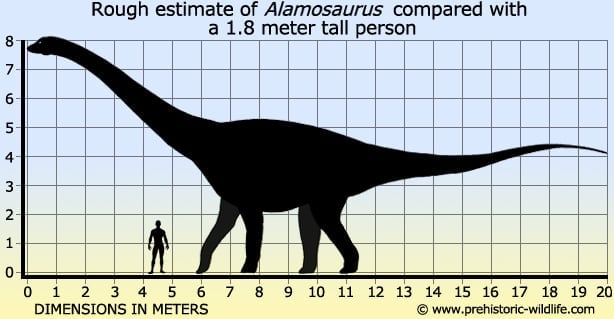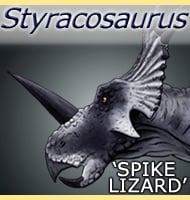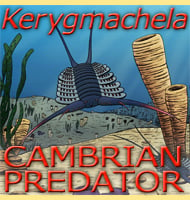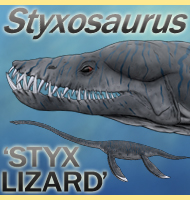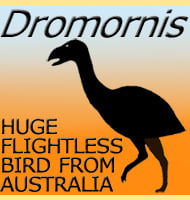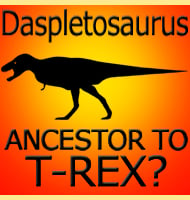In Depth
The one ‘fact’ that is often presented for Alamosaurus is that it is named after the Alamo, the famous mission in San Antonia that was the site for one of the most important battles in the Texas Revolution. However this is completely false and the truth of the matter is that the first Alamosaurus remains which were found in New Mexico were so named because they came from the Ojo Alamo Formation.
Alamosaurus was a reasonably large titanosaur, the most common group of more advanced sauropod dinosaurs that were the most common during the Cretaceous. A complete adult specimen of Alamosaurus continues to prove elusive, although this is a common problem for most large dinosaurs in general. Juveniles however are often more complete because their smaller bodies are more easily covered by sediment, and comparison of juvenile fossils with those of adults has led to estimates of around twenty meters long, give or take a meter or two, for adult Alamosaurus. A skull of Alamosaurus is also currently unknown, although associated teeth are quite slender, possibly for snipping at tree tops. Alamosaurus also seems to have lacked the osteoderm armour (bony plates that grew in the skin) that is known to be present in many other titanosaurs since out of all the known Alamosaurus remains, no osteoderms have yet been found.
More importantly, the presence of Alamosaurus in the south western portions of the United States is proof that the sauropods had not disappeared completely from North America during the Cretaceous. Sauropods however are usually associated with dryer and higher up landscapes, and these areas do not seem to have been that abundant, due mainly to the Western interior Seaway submerging most of the central portions of North America. As such it is quite conceivable that the distribution of sauropods like with most animals is down to the availability of suitable habitat.
How Alamosaurus came to live within the United States at the end of the Cretaceous is a question that has caused some confusion for some since for a long time the popular conception of sauropods was that they mostly disappeared from North America at the end of the Jurassic. This idea is based upon the observation that fossils of sauropods were more common in North America at the end of the Jurassic, but seem to have been replaced by ornithischians like hadrosaurs and later on ceratopsian dinosaurs during the Cretaceous. However the saying that absence of evidence is not necessarily evidence of absence is commonly used in palaeontology, and slowly but surely Cretaceous age sauropods are slowly but surely being discovered in North America with examples including Astrodon, Sauroposeidon and Cedarosaurus amongst others. Slowly, Cretaceous sauropod (or rather more specifically titanosaur) genera are coming together to help complete a picture of the dinosaurian fauna of North American ecosystems where titanosaur sauropods are actually still quite common, although still perhaps not as common as their late Jurassic ancestors. There are too alternative theories concerning how Alamosaurus came to live in North America. One is a direct Asian origin where Alamosaurus or immediate ancestors to it crossed the Bering Strait land bridge and spread down to the south-western regions where the habitat may have remained more suitable for a stable and permanent population. This is in part supported by the placement of Alamosaurus within the Opisthocoelicaudiinae group of titanosaurs, the type genus of which, Opisthocoelicaudia, is currently only known from Asia. However this group also sits within the Saltasauridae and Alamosaurus is seen to have a lot of similarities with the type genus of this group, Saltasaurus. This has led to speculation of a South American origin for Alamosaurus, although the main problem here is that South America is thought to have been separated from North America during the Cretaceous by ocean. Additionally other strictly South American dinosaurs such as the abelisaur theropods are still not known in North America, and vice versa, North American dinosaurs like tyrannosaurs are not known in South America.
Altogether the arguments for a South American origin are not that convincing, but one possibility that may explain these similarities is convergent evolution. This is simply where two animals (or in this case dinosaurs) that are separated by time and/or geography find themselves in the same survival conditions and so physically change to carry near identical adaptations for coping with their survival requirements. This principal has been observed countless times, and where the animals share a common ancestor and similar biology, the similarity is just the more likely to occur.
Dinosaur art and popular fiction often depicts life and death struggles between large theropods such as tyrannosaurs and long necked sauropods. As stated above this was long thought unlikely to have happened in North America, but Alamosaurus did live in North America at a time that saw large tyrannosaurs such as Daspletosaurus and Bistahieversor roaming the land in search of prey. A fully grown Alamosaurus may still have been too much of a challenge for these dinosaurs, but a smaller juvenile would have certainly been within their predatory scope. Other dinosaurs that Alamosaurus shared its habitat with include the ceratopsian dinosaur Torosaurus and the hadrosaur Edmontosaurus. Additionally it would have also been possible to see the giant pterosaur Quetzalcoatlus soaring through the skies of the time.
Further Reading
– A new sauropod dinosaur from the Ojo Alamo Formation of New Mexico. – Smithsonian Miscellaneous Collections 72(34):1-9 – Charles W. Gilmore – 1922. – A juvenile specimen of the sauropod Alamosaurus sanjuanensis from the Upper Cretaceous of Big Bend National Park, Texas. – Journal of Palaeontology. 76(1): 156-172. – T. M. Lehman & A. B. Coulson – 2002. – First isotopic (U-PB) age for the Late Creatceous Alamosaurus vertebrate fauna of West Texas and its significance as a link between two faunal provinces. – Journal of Vertebrate Paleontology. 26: 922-928. – T. M. Lehman, F. W. McDowell & J. N. Connelly – 2006. – The First Giant Titanosaurian Sauropod from the Upper Cretaceous of North America. – Acta Palaeontologica Polonica. 56 (4): 685. – D. W. Fowler & R. M. Sullivan – 2011. – Osteoderms of the titanosaur sauropod dinosaur Alamosaurus sanjuanensis Gilmore, 1922. – Journal of Vertebrate Paleontology. 35 (1). – M. T. Carrano, M. D’Emic – 2015.
